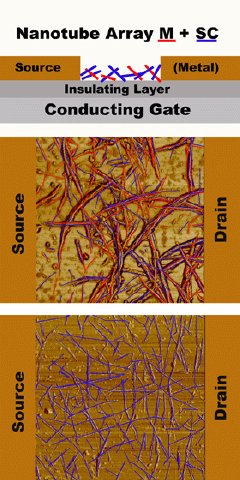Jan 9 2009
Scientists at DuPont and Cornell University in Ithaca, N.Y., have used a simple chemical process to convert mixtures of metallic and semiconducting carbon nanotubes into solely semiconducting carbon nanotubes with electrical characteristics well-suited for plastic electronics. This new finding, reported in the January 9 issue of the journal Science, identifies a commercially viable path for the production of bulk quantities of organic semiconducting ink, which can be printed into thin, flexible electronics such as transistors and photovoltaic materials for solar cell technology.
 Atomic Force Microscope image of carbon nanotubes before and after processing.
Atomic Force Microscope image of carbon nanotubes before and after processing.
The research team included DuPont research fellow Dr. Graciela Blanchet, Cornell University associate professor of materials science and engineering George Malliaras, Cornell/DuPont post-doctoral fellow Mandakini Kanungo and DuPont research chemist Helen Lu. Their article was titled, “Suppression of Metallic Conductivity of Single-Walled Carbon Nanotubes by Cycloaddition Reactions.” The research was funded by a U.S. Air Force grant to Cornell University.
Since their discovery in the early 1990s, carbon nanotubes have been viewed as potentially revolutionizing the electronics industry. However, the fact that carbon nanotubes are produced as complex mixtures can greatly limit their applications. In 2003, DuPont scientists published in Science a method to separate carbon nanotubes using DNA. DuPont has continued to investigate these materials. The current development is a significant advancement in this pioneering field, and is a more promising approach to developing semiconductor applications of carbon nanotubes.
“A significant limitation in electronic application of carbon nanotubes has been the difficulty in separating metallic from semiconducting carbon nanotubes,” Graciela said. “Our research uncovered a potentially low cost route to suppress the conductivity of the metallic tubes without requiring further separation of nanotubes by type.”
“We are looking forward to exploring the use of this material in a wide range of devices for applications such as novel organic photovoltaic structures,” Malliaras said.